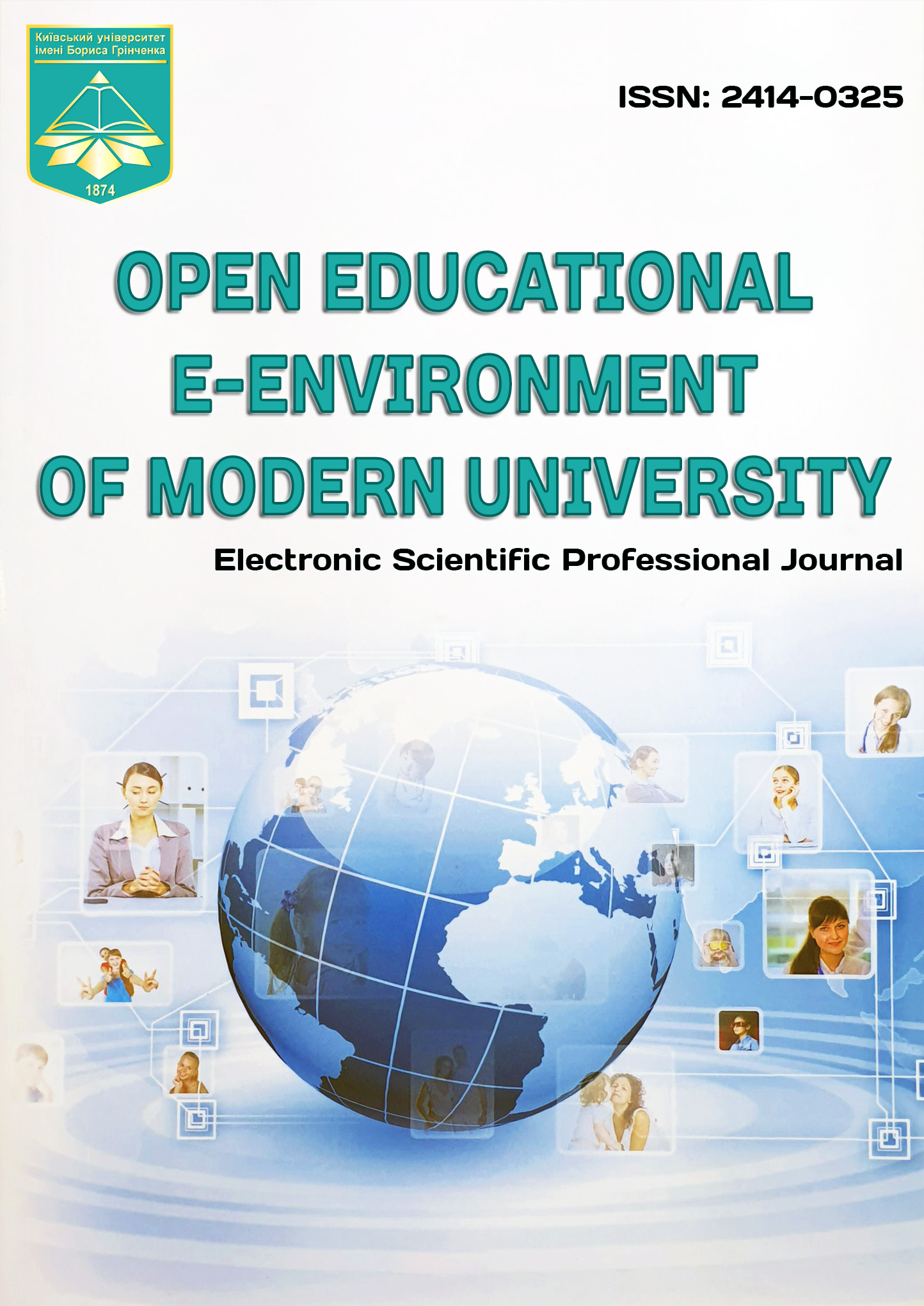ORGANISATION OF LEVEL-BASED DIFFERENTIATED INSTRUCTION FOR HETEROGENEOUS GROUPS IN MOODLE
DOI:
https://doi.org/10.28925/2414-0325.2023.147Keywords:
differentiated instruction; Moodle; knowledge level; e-learning course; students’ needsAbstract
Nowadays adaptation of the learning process to students’ needs is one of most frequently addressed topics in pedagogical research. Different aspects of this topic are studied both by Ukrainian and foreign scientists. The paper deals with one of the questions in the field - knowledge level diversity within an academic group in higher education institutions. The difference in knowledge level influences not only the ability to achieve learning outcomes but also the motivation to study. Thus, providing students with possibilities to study at their own level and learning paths might increase their interest in the discipline and improve their results. Differentiated instruction is considered as a way to meet the needs of multi-level groups. Moodle is addressed as a means of level based differentiated instruction as many higher education institutions use learning management systems to support the learning process. The results of the teachers survey at Borys Grinchenko Kyiv University are used as a background for differentiated e-learning course design planning. The main requirements to a differentiated e-learning course design are defined: opportunities to define students’ levels and knowledge gaps, easy navigation for students in the diversity of tasks and materials, ability for teachers to combine various levels tasks in the same activities, suitability for flexible groupings, moderate time consumption for design and maintenance of the e-learning course. The model of e-learning course design for level based differentiated instruction is offered which includes testing, adapting learning materials to the students’ needs, groups and grouping settings, formative assessment, summative assessment and feedback. Utilisation of Moodle activities and resources for implementation of all the model components is described. The role of groups and groupings in the implementation of differentiated instruction is underlined and their usage in Moodle is described.
Downloads
References
van Seters, J., Ossevoort, M., Goedhart, M. & Tramper, J. (2011). Accommodating the difference in students' prior knowledge of cell growth kinetics. Electronic journal of biotechnology, 14(2). https://doi.org/10.2225/vol14-issue2-fulltext-2 https://www.scielo.cl/scielo.php?pid=S0717-34582011000200001&script=sci_arttext
Ingunn Eikeland & Stein Erik Ohna (2022) Differentiation in education: a configurative review. Nordic Journal of Studies in Educational Policy, 8:3, 157-170. https://doi.org/10.1080/20020317.2022.2039351
Tomlinson, C. A. (Ed.) (2005). Differentiated instruction. Lawrence Erlbaum Associates.
Esra Meşe & Enisa Mede (2022). Using digital differentiation to improve EFL achievement and self-regulation of tertiary learners: the Turkish context. Innovation in Language Learning and Teaching. https://www.tandfonline.com/doi/full/10.1080/17501229.2022.2043872
Zoi Karatza (2019). Information and Communication Technology (ICT) as a Tool of Differentiated Instruction: An Informative Intervention and a Comparative Study on Educators’ Views and Extent of ICT Use. International Journal of Information and Education Technology, vol. 9, no. 1, pp. 8-15. https://doi.org/10.18178/ijiet.2019.9.1.1165
Wong, B.S., Chue, K.L., Ali, R.B. et al., B.S., Chue, K.L., Ali, R.B. et al. (2023). Differentiated instruction: a comparison of motivation and perceived competence between students with high and low readiness levels. Educ Res Policy Prac 22, 139–151. https://doi.org/10.1007/s10671-022-09323-2
Moallemi, R. (2023). The relationship between differentiated instruction and learner levels of engagement at university. Journal of Research in Innovative Teaching & Learning, Vol. ahead-of-print No. ahead-of-print. https://doi.org/10.1108/JRIT-07-2022-0041
Osadcha, K., Osadchyi, V., Spirin, O. & Kruglyk, V. (2021) Implementation of individualization and personalization of learning by means of Moodle. Youth and Market., 1/187, 38-43. http://mir.dspu.edu.ua/article/view/228274 (in Ukrainian)
Morze, N., Varchenko-Trotsenko, L., Terletska, T., & Smyrnova-Trybulska, E. (2021, March). Implementation of adaptive learning at higher education institutions by means of Moodle LMS. Journal of physics: Conference series, Vol. 1840, No. 1, p. 012062. IOP Publishing. https://doi.org/10.1088/1742-6596/1840/1/012062
Tomlinson, C.A. (2014) The Differentiated Classroom: Responding to the Needs of All Learners. 2nd Edition, ASCD, Alexandria.
Ormrod, J. E. (2014). Human Learning (7th ed.). Pearson.
Furnham, A., Moutafi, J., & Crump, J. (2003). The relationship between the revised NEO-Personality Inventory and the Myers-Briggs Type Indicator. Social Behavior and Personality: An International Journal, 31(6), 577–584. https://doi.org/10.2224/sbp.2003.31.6.577
Wyman, P. J., & Watson, S. B. (2020). Academic achievement with cooperative learning using homogeneous and heterogeneous groups. School Science and Mathematics, 120(6), 356-363. https://doi.org/10.1111/ssm.12427
Tomlinson, C. A. (2017). How to differentiate instruction in academically diverse classrooms (3rd ed.). Association for Supervision and Curriculum Development. https://files.ascd.org/staticfiles/ascd/pdf/siteASCD/publications/books/HowtoDifferentiateInstructioninAcademicallyDiverseClassrooms-3rdEd.pdf
Domina, T., McEachin, A., Hanselman, P., Agarwal, P., Hwang, N., & Lewis, R. W. (2019). Beyond tracking and detracking: The dimensions of organizational differentiation in schools. Sociology of Education, 92(3), 293-322. https://doi.org/10.1177/0038040719851879
Magableh, I. S. I., & Abdullah, A. (2021). The Impact of differentiated instruction on students’ reading comprehension attainment in mixed-ability classrooms. Interchange, 52(2), 255-272. https://doi.org/10.1007/s10780-021-09427-3
Published
How to Cite
Issue
Section
License
Copyright (c) 2023 Terletska T., Glushak O., Varchenko-Trotsenko L.

This work is licensed under a Creative Commons Attribution-NonCommercial-ShareAlike 4.0 International License.













1.jpg)








